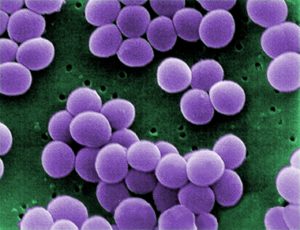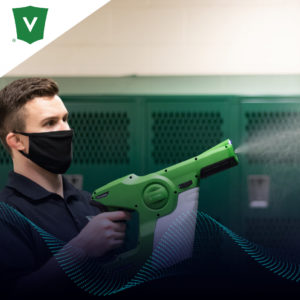Differences between Bacteria and Viruses
During the pandemic there has been a lot of interest and questions about disinfecting against various pathogens including the human corona virus SARS-COV-2, the cause of COVID-19.
This blog post will shed some light on the differences between viruses and bacteria as it applies to disinfecting in the hope that it can help in the development of an effective infection control strategy in public facilities.
Bacteria: Live Fruitful and Multiply
Bacteria are free living cells that can live and multiply inside the body or out. Most bacteria do not make us sick, in fact bacteria are essential for life. Bacteria help us digest food, provide nutrients to our bodies and help us fight off disease.
The decomposition of any organic material (i.e. dead animals, plants, leaves, food waste) occurs via a bacteria
consumption process. If organic materials did not decompose, we would have a big problem, we wouldn’t be here!
Pathogenic bacteria compromise a relatively small group of bacteria that can make us sick. If we ingest food contaminated with Salmonella or E-Coli bacteria, we can become quite sick. Infections in wounds are often caused by Staphylococcus bacteria and Streptococcus bacteria can cause Strep throat. A certain type of staph called Methicillin Resistant Staphylococcus Aureus or “MRSA” can cause an infection that is resistant to the standard antibiotic treatment and can be deadly if not readily diagnosed.
As little as 10 bacteria replicating every 20 minutes can grow into 2.6 million bacteria in the course of 6 hours. The chart at right shows the exponential affect of unchecked bacterial growth.
Viruses want to become a house guest inside our bodies
Unlike bacteria, viruses can not reproduce on their own, so they are not considered ‘living’.  They require a “host” such as a human or other animal. Viruses invade your body’s cells in order to multiply and consequently make you sick.
They require a “host” such as a human or other animal. Viruses invade your body’s cells in order to multiply and consequently make you sick.
Illnesses caused by viruses include COVID-19, the common cold, Influenza, Chicken Pox, and HIV/AIDS.
While viruses can remain active on surfaces for a length of time, without a host they will eventually become inactive. The length of time has many variables including temperature, humidity, the type of surface, and the particular virus. For example, it is believed COVID-19 can remain on some surfaces up to 72 hours.
VIRUS vs Bacteria Comparison Table
| Question | Virus | Bacteria |
| Does it Make People Sick? | Most Viruses make humans or animals sick. | Less than 1% of bacteria induce illness or are classified as ‘pathogenic’. |
| Can it reproduce on surfaces? | No, a virus requires a host to survive. | Can exponentially reproduce under the right conditions. |
| How long does it last on a surface? | Variable, but will eventually die on a surface. | It will multiply if conditions are right, namely temp, water, and a food source. |
| How large is it? | Viral particles are 10 times smaller than bacteria. | E-Coli for example is about 0.5 micrometers in diameter. |
| How is it transmitted”? | Through air, human contact, ingestion, exchange of bodily fluids or touching a surface. | Through air, human contact, ingestion, exchange of bodily fluids or touching a surface. |
Treating Illnesses caused by Bacteria and Viruses
Serous illnesses caused by bacteria and viruses are treated differently. In many cases the human body’s own defense  mechanisms can fight off the illness.
mechanisms can fight off the illness.
Viral illnesses are warded off by the human body. There are anti-viral medications that can help ward off viral illness, but there is no simple cure.
For bacterial infections, modern medicine has produced anti-biotics to help the body recover from infections. Penicillin discovered in 1928 and widely used since 1942 was the first in the line of many antibiotics that have saved millions lives over the years.
Bacterial Evolution: Superbugs
Anti-biotics are only effective on bacterial infections, but it can be difficult to determine if an illness is bacterial or viral, so sometimes anti-biotics get wrongly prescribed to treat viral infections. One consequence of “over” prescribing of anti-biotics is that bacterial pathogens can evolve to resist the normal treatments. These “Super Bugs” can produce serious illnesses that can be deadly.
Superbugs you might have heard of include MRSA (Methicillin Resistant Staphylococcus Aureus) and VRE (Vanomycin Resistant Enterococcus). Infections caused by these “superbugs” do not respond to normal anti-biotic treatments and require more powerful drugs.
The Ever Changing Virus: Variants
Each day we are hearing in the news about the emergence of new virus strains of the human corona virus that causes COVID-19. There are some indications the strains are more virulent and can produce more serious illness, creating concerns amongst public health professionals.
All viruses constantly change through mutation and as expected, researchers have discovered new variants of the human corona virus that causes COVID-19. A new virus variant has one or more mutations that differentiate it from the predominant virus variants already circulating among the general population. Certainly the Delta Variant we have heard so much about is more contagious than earlier variants and has become the dominant cause of new COVID-19 cases, particularly in unvaccinated individuals.
Virus mutations are the reason influenza vaccines change each year, as medical professionals try to determine what the dominant variants will be and formulate a vaccine that targets the particular variant.
Disinfecting Q & A: Below are some questions about disinfecting where you can apply your new found knowledge about Bacteria and Viruses.
Do disinfectants offer residual protection against pathogens when used on surfaces?
This has been a common question during the pandemic with some companies claiming to have a product that when used on surfaces, will protect the surface from viruses and bacterial growth for extended times, some even claiming 90 day protection. Unfortunately, making public health claims of residual protection against human viral pathogens is not only against the law, it may provide a false sense of security that surfaces are protected from transmitting disease, resulting in more infections.
In short, disinfectants inactivate the pathogens present on the surface and do not offer residual protection on surfaces.
Are disinfectants effective against SUPERBUGS?
Many disinfectants have specific kill claims for the most common Superbugs like MRSA or VRE.
What is the difference between sanitizing and disinfecting?
Disinfecting is eradicating a pathogen from a surface, sanitizing is reducing bacterial pathogens to safe levels. Below are the official definitions from the EPA, the regulatory agency for disinfectant:
“Disinfectant means a substance, or mixture of substances, that destroys or irreversibly inactivates bacteria, fungi and viruses, but not necessarily bacterial spores, in the inanimate environment.”
“Sanitizer means a substance, or mixture of substances, that reduces the bacteria population in the inanimate environment by significant numbers, but does not destroy or eliminate all bacteria.
If I sanitize, am I killing viruses?
NO, sanitization is related to reduction of bacteria on a surface.
Are disinfectants effective against virus variants?
YES, disinfectants are considered effective against virus variants. If a disinfectant claims to be effective at killing SARS-CoV-2, the cause of COVID-19, it is effective against all known variants including the DELTA variant.
If a surface is sanitized, are viruses being eradicated such as the virus that causes COVID-19?
NO, sanitization reduces bacterial pathogens, but does not eliminate them.
Visit us on LinkedIn
Connect with us on Twitter
Multi-Clean is a manufacturer of professional sanitation and floor care products. We manufacture commercial grade disinfectants and sanitizers, and offer the Victory Electrostatic Sprayers for E-Spray Disinfecting.
To Learn more, visit us on our website or fill in the inquiry form below.









